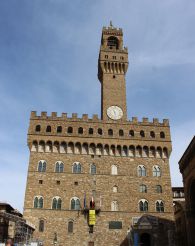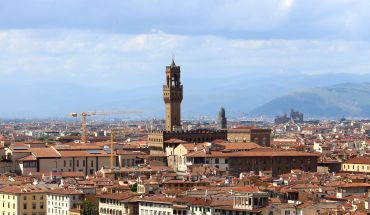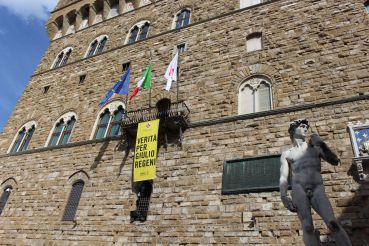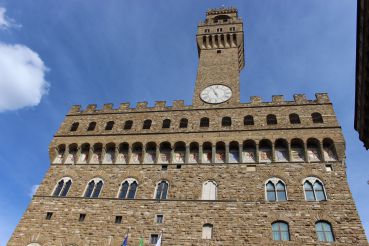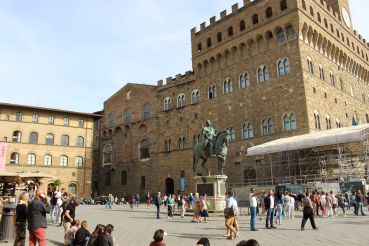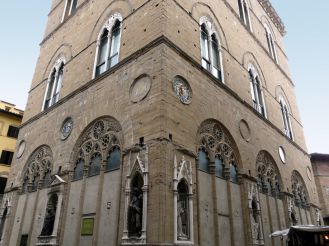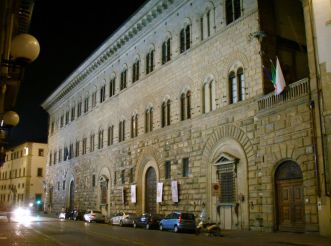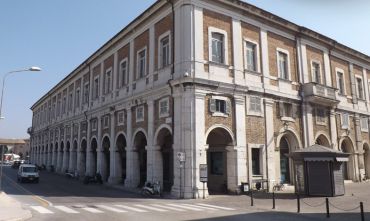Palazzo Vecchio, Florence
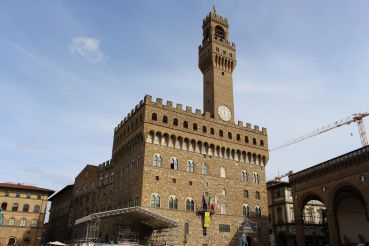
The Palazzo Vecchio in Florence is one of the most memorable sights of the city. The palace was built in the 13th century. Historically the place used to house the city authorities, today, however, the palazzo is considered to be a museum that possesses a lot of exhibits. The Arnolfo Tower crowns the top of the former town hall which, incidentally, often serves as a landmark in the city, because it is one of the tallest buildings in Florence. The Palazzo was built in the center, on Piazza della Signoria.
The Palazzo Vecchio in numbers and facts
- The construction date is between 1298 and 1314.
- The height of the Arnolfo Tower is 95 meters.
- At the entrance to the palazzo, there is a replica of the statue of David made in 1504 by Michelangelo; the original was moved to the Accademia Gallery, also in Florence.
- The clock on the tower of the town hall was created by Giorgio Lederle and dates back to 1667.
- Different artists worked on the Vecchio Palace during different periods of time, namely, on its the exterior and interior design, sculptures and other decorations: Arnolfo di Cambio, Michelozzo di Bartolomeo, Giorgio Vasari, da Vinci, Michelangelo, Andrea del Verrocchio, Sandro Botticelli, and others.
- The palazzo is shaped like a cube.
- There are two small rooms in the town hall’s tower that once served as the place of imprisonment of Cosimo de' Medici (founder of the Medici dynasty) in 1435 and the Italian reformer Girolamo Savonarola in 1498.
History of the Palazzo Vecchio
The beginning of the construction of the Palazzo Vecchio in Florence dates to 1299. Back then the citizens decided to build a government residence that would be well fortified and protected from possible manifestations of aggression. The architect Arnolfo di Cambio was put in charge of the project. Today the tower of the Town Hall carries his name.
Architectural features:
- The Palazzo del Toscano in the city of Volterra was chosen to be the palace’s prototype.
- Rough-hewn stones were used for the construction.
- Windows were designed in the Gothic style.
- The decorations under the arches are the coat of arms of the Florentine Republic. Some of the arches themselves used to serve as embrasures.
- Above the entrance, there is an inscription made in 1851 in Latin – "Rex Regum et Dominus Dominantium" which means "King of kings and Lord of lords".

In the 15th century, a new form of political regime – signoria – was declared in the territory of Florence. Virtually all power was in the hands of the signora. Since then the palace had been called the Palazzo della Signoria, hence the name of the square.
In the middle of the 16th century, the Tuscan duke Cosimo I de' Medici who had previously considered his main residence to be the Palazzo della Signoria, moved to the Palazzo Pitti. After that, he officially renamed the Palazzo della Signoria to the Palazzo Vecchio which means "the old palace."
Cosimo ordered to move the administration to Uffizi, and Giorgio Vasari to build an overpass from the Palazzo Vecchio through Uffizi and the Ponte Vecchio to the the Palazzo Pitti. Today this passage is called the Vasari Corridor. Part of the corridor is available for tourists, a guide for the tour through will be required.
Exhibits and rooms of the Palazzo Vecchio
Be sure to go inside the Vecchio Palace! The interior should definitely impress you. From the luxurious courtyards and interesting exhibits in the rooms where the original interiors have been partially preserved or recreated, to the stunning view of the entire Florence from the Arnolfo Tower.
Here are the most remarkable halls and sights of Palazzo Vecchio:
- The Michelozzo courtyard (Cortile di Michelozzo). It was named after its designer and decorated in 1453. This is, so to speak, the first room which you will enter through the palazzo’s central entrance. High columns with carvings and frescoes made by Vasari (1565), dedicated to Austrian cities, are quite impressive. Check out the frescos! Perhaps you will recognize Graz, Innsbruck, Linz, Vienna and other cities on them. The highlight of the courtyard – a fountain with a replica of the sculpture "Cupid with a dolphin" by Andrea del Verrocchio.
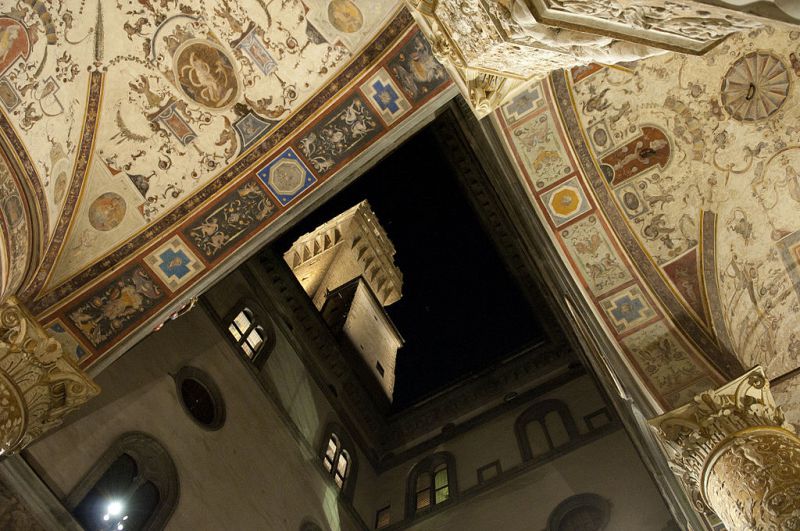
- Second and third patios. Columns in the second courtyard date back to 1494 and are much massive. The third one was used for administration offices. Between the first and second courtyard, there is a staircase made by Giorgio Vasari which leads to the so-called Hall of Five Hundred (Salone dei Cinquecento).
- Hall of Five Hundred (Salone dei Cinquecento). Council meetings that consisted of 500 members were held here. Da Vinci and Michelangelo worked on the canvases on the walls, and by the way, this is the only known place where the artists worked together. Frescoes were ordered to celebrate the power of the Florentine Republic in the late 15th century. Today on the walls you can find an artwork made by, for example, Vasari – "Battle of Marciano".
- The Studiolo of Francesco I. It was both a study and a secret room. There are no windows in it, but there are many frescoes, sculptures and paintings of the Vasari school dedicated to the elements of Earth, Water, Air and Fire. Rare exhibits collected by the monarch himself were kept in here. The room is valuable as an example of how a room of an introverted monarch would look like.
- Apartments of the Elements. This includes five rooms and two balconies: a room (it has frescoes-allegories of Water, Fire and Earth), the Terrace of Saturn (named after the fresco on the ceiling), Room of Hercules (depicts the exploits of Hercules in the frescoes, and there is a collection of semiprecious stones), House of Medici (in this room a collection of frescos portraying deities is put on display), Room of Jupiter (named because of the frescoes made by Stradanus), Room of Cybele (the fresco on the ceiling of the room is called "Triumph of Cybele"); each one overlooks one of the inner courtyards.
- Hall of Geographical Maps of 1563 (Guardaroba). The name speaks for itself. You will find out what time and astronomy was like in the 16th century. All this is shown on maps, globes and many other interesting exhibits, brought from different parts of the world.
- The Quartiere del Mezzanino and Loeser Bequest. Both are located between the first and second floor, encircling the courtyard of Michelozzo. It is one of the oldest buildings in the palazzo, dates back to the early 14th century. Here you will see the most preserved and unmodified part of the palace. In the mid-20th century, the American collector Charles Alexander Löser donated his collection to a new museum in the Palazzo Vecchio. Today the museum carries his name. The collector was inspired by Florence and the collection is partly dedicated to the art of old times. For instance, the "Angel" created by Tino di Camaino, "Madonna and Child" by Pietro Lorenzetti can be found here.
- The Arnolfo Tower and the terraces. This place is of the greatest interest due to it having a nice view from the tower’s observation deck.
The interesting places of Palazzo Vecchio listed here are not the only ones. Even though some of the rooms are closed for visiting, the palace really has something to offer, especially to lovers of history, architecture and antiquity.
How to get
It's easier to say how to get there by foot, because the Palazzo Vecchio is located in the pedestrian center of Florence. If you need public transport anyway, look for the Galleria Degli Uffizi stop which you can reach by the bus C1. On the other side of the museum, there is the Condotta stop, the bus C2 includes it into its route.
Opening hours
The museum (the main rooms of the palace) and the archaeological site welcome visitors:
- from October to March from 09:00 to 19:00 every day, except Thursday (until 14:00 on this day);
- from April to September from 09:00 to 23:00 every day, except Thursday (until 14:00 on this day).
The Quartiere del Mezzanino and Loeser Bequest: every day, except Thursday, from 09:00 to 19:00; on Thursdays and holidays until 14:00.
The Arnolfo Tower and its terraces:
- children under 6 years of age are not allowed to enter;
- children aged 6–18 can enter only if accompanied by adults;
- from October to March from 10:00 to 17:00 every day, except Thursday (until 14:00 on this day);
- from April to September from 09:00 to 21:00 every day, except Thursday (until 14:00 on this day).
Everything is closed during Christmas.
Admission: ranges from 4 to 18 euros, depending on the ticket type and discounts. Ticket that costs 18 euro allows to enter all tourist areas of the palazzo. In the summer, you can purchase a night tour to the observation deck (4 euros).



